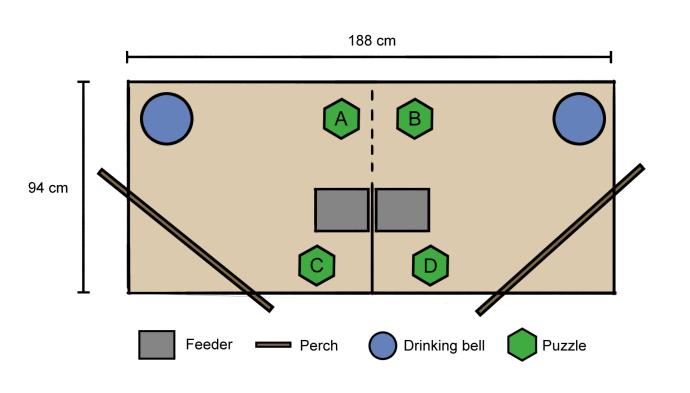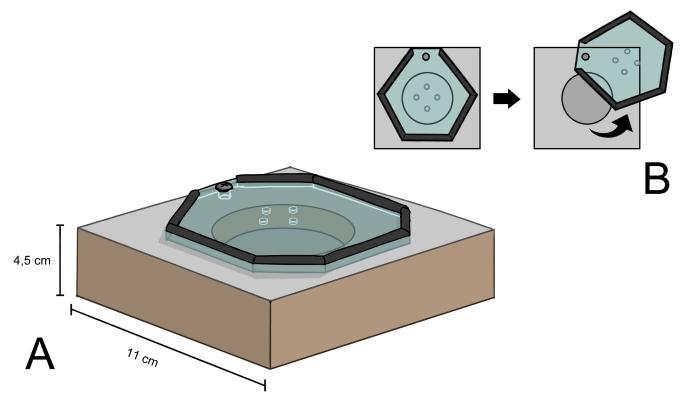Methods
Sample size and composition
The sample consisted of 53 adult female birds (observers). Of these, 12 were White Leghorns (WLs) and 41 were Red Junglefowl (RJF). The birds fell into four groups: five naïve WLs (WL controls), seven “guided” WLs, 20 naïve RJF (RJF controls), and 21 “guided” RJF.
Additionally, two pre-trained female demonstrator birds (demonstrators) were used. There was one demonstrator for each of the two subspecies and each demonstrated only to their respective subspecies.
Testing pen
During the course of the experiment, the birds were placed in a testing pen of 1.77 m2 (94 x 188 x 179 cm). This pen consisted of two connected chambers (94 cm x 94 cm x 179 cm), which were kept separated by a see-through wire mesh on one side and a solid cardboard wall on the other (see figure below).

A diagram representing the testing pen and object layout within it. The dashed line indicates a wire mesh partition. The letters represent the different positions of the puzzle throughout the experiment: A – puzzle placement during demonstrations (within 5 cm of the wire mesh), B – puzzle placement during guided trials, C and D – puzzle placement during naïve trials.
The puzzle apparatus
The puzzle apparatus consisted of a heavy baseplate with a circular dish in the middle, in which food rewards were placed (see figure below, A). A transparent perforated plexiglass lid covered this baseplate. It was attached with a screw in the top centre part, allowing it to be twisted away to either side to reveal a food reward (see figure below, B).

An illustration of the puzzle apparatus used in the experiment (A) and a schematic representation of how the lid would be horizontally twisted to reveal the dish below (B).
Experimental procedure
During testing trials with demonstrations, the puzzle was placed within a 10 cm distance from the wire mesh. A single demonstration consisted of the demonstrator bird approaching the puzzle and moving the lid to obtain the food reward (sweet corn). This demonstration was repeated 5 times. After the demonstrations, the refilled puzzle was given to the observing (“guided”) bird to attempt to complete the task of opening the lid. The experimenter then left the room so as not to influence the test outcome. Birds had access to the puzzle for 30 minutes.
The control trial procedure was similar to that described above, except no demonstrations took place. Both chambers held a control (“naïve”) bird each. The puzzle was filled with food and placed by the solid cardboard partition, behind the metal feeder to ensure that only one bird at a time would be able to see it. As in guided trials, control birds had access to the puzzle for 30 minutes and the experimenter would leave the room during this time.
Behavioural measures
Several behavioural measures were extracted from video recordings of the test trials:
• Latency to approach the puzzle apparatus (head within 5 cm) (s)
• Furthest lid position attained (%)
• Number of pecks directed at the puzzle apparatus (n)
• Number of times the puzzle apparatus was approached (n)
Additionally, general activity behaviours were recorded over the 30 minute test period using the one-zero sampling technique at 1 min intervals. These were:
• Interaction with the puzzle apparatus
• Foraging
• Preening
• Feeding (from the metal feeder box)
• Lying down
• Perching
• Dust-bathing
• Drinking
Responsible for this page:
Director of undergraduate studies Biology
Last updated:
05/10/21
